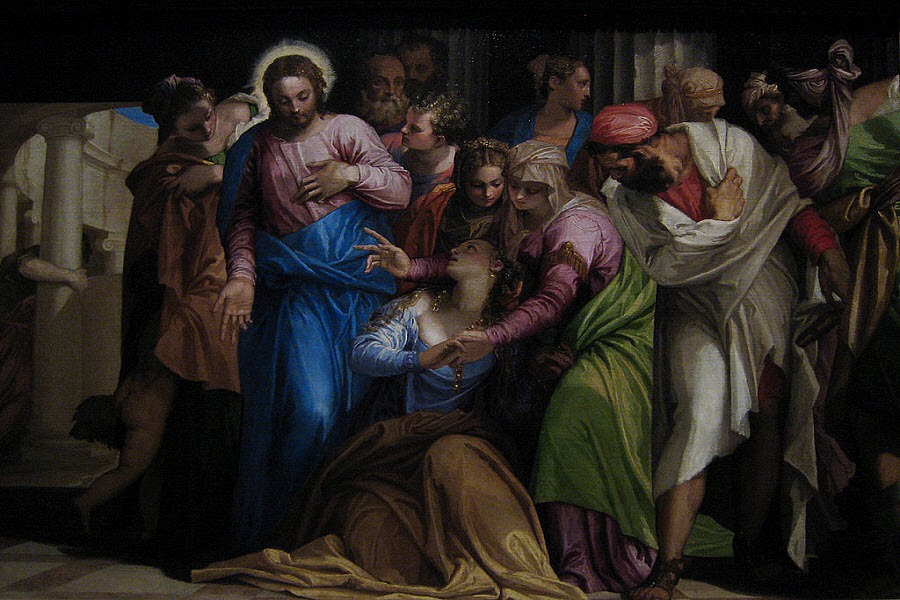
Thirteenth Sunday in Ordinary Time
07-01-2018All©2018 Liturgical Publications, IncToday's Gospel offers a rare framework -- a story in a story. Most of the healing miracles are standalone encounters. One person approaches Jesus, demonstrates faith, and is healed. The evangelist tells the next story. This Gospel, however, is different. Jesus is on his way to heal one person, a young girl of twelve, and is interrupted on his journey by "a woman afflicted with hemorrhages." She bravely approaches Jesus in a crowd, despite being ritually unclean from her bleeding, and stretches out to touch his cloak. She is healed! Jesus meets her eye, confirms her faith, and continues on to resurrect the young girl.
Reading this passage, it might be easier to identify with one story -- the long-suffering woman or the young, innocent girl -- and to move past the other. But here they sit side by side. The girl is twelve. The woman has been suffering for twelve years. For the Gospel writers, number parallels have deep symbolic meaning.
Between the woman and the young girl, we are not one or the other. We are both. None of us had a perfect childhood, perfect families, or a perfect peer group. As we endure pain, disappointment, or unmet expectations, it can feel like a part of our childhood hopes have died. Our coping mechanisms, social adaptations, and hidden secrets can make us the "walking wounded" in some respects. Jesus wants to do more than simply staunch the bleeding. His healing hand makes dead things come alive. He awakens the dreams that are asleep. This process requires prayer, conversations with trusted community and spiritual mentors, and critical looks at difficult areas of our life. However, we can believe the words of our Lord. If we approach Jesus in faith, believing that he wants to heal and save, we, too, will hear his calming words spoken over the hurts of our life. "I say to you, arise!" "Go in peace."
El Evangelio de hoy nos muestra un momento cumbre con un doble episodio en la vida pública de Jesús. Sana a una mujer de edad avanzada y resucita a una adolecente de doce años. ¡Hermosa, admirable providencia de Dios! Doble acto de fe, doble milagro y doble esperanza para el que cree. Una, temerosa por haber tocado a Jesús, recibe palabras alentadoras: "Hija, tu fe te ha salvado; vete en paz y queda sana de tu enfermedad" (Mc. 5:34). A la segunda joven, Jesús toma de la mano y le dice las siguientes palabras: "'Talitá kumi', que quiere decir: 'Niña, te lo digo, ¡levántate!'" (Mc. 5:42-43). Y agrega: "denle de comer".
Sanar a las personas de sus enfermedades era un aspecto importante del ministerio de Jesús. Pero observemos que la tarea de sanar requería fe, una fe grande de parte de aquel que necesitaba sanidad. La fe es un regalo de Dios, que se experimenta por la cercanía, la relación y la unidad con Jesús. No basta solo con decir que se tiene fe, hay que dialogar con el Maestro para obtener beneficios. Entonces, ¿por qué cuando pedimos a Dios que sane nuestras enfermedades nos gana la desesperación al no tener una respuesta inmediata? Es bueno recordar que el solo hecho de pedir por la sanidad de nuestras enfermedades y otros tantos problemas ya es un gran paso de acercamiento a Jesús. Pidamos más fe este domingo, que nuestro acercamiento a Jesús nos lleve a luchar por la justicia y la paz tan necesitada en este tiempo de incertidumbre. ¡Qué no muera la confianza en Dios! Hay vida en aquello que creemos muerto en nosotros. Pidamos a Dios que lo resucite.
BACK TO LIST